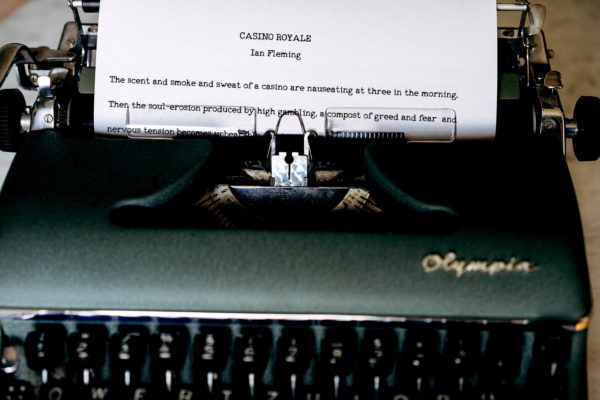We explore all Ian Fleming’s books in order of publication, with a focus on his non-Bond writings.

When Ian Fleming published his first novel, Casino Royale, in 1953, he could scarcely have imagined the cultural phenomenon it would spark. Best known for creating the iconic James Bond, Fleming’s influence extends far beyond the world of espionage fiction.
Before becoming a novelist, Fleming enjoyed a successful career as a journalist and naval intelligence officer, both of which played a crucial role in shaping his writing. His time in intelligence provided the inspiration for the Bond novels, while his journalistic work honed his attention to detail and his distinctive style.
Although the James Bond series remains his most famous creation, Ian Fleming’s bibliography extends far beyond 007. His body of work also includes non-fiction books, insightful travel writing, and even a well-known children’s story.
Ian Fleming’s books in order of publication
In this guide, we provide a complete list of all Ian Fleming’s books in order of publication. For detailed information on his James Bond books, please visit this page.

- The Black Daffodil (1928)
- Casino Royale (1953)
- Live and Let Die (1954)
- Moonraker (1955)
- Diamonds Are Forever (1956)
- From Russia, with Love (1957)
- The Diamond Smugglers (1957)
- Dr No (1958)
- Goldfinger (1959)
- For Your Eyes Only (1960)
- Thunderball (1961)
- The Spy Who Loved Me (1962)
- On Her Majesty’s Secret Service (1963)
- Thrilling Cities (1963)
- You Only Live Twice (1964)
- Chitty-Chitty-Bang-Bang: The Magical Car (1964)
- The Man with the Golden Gun (1965)
- Octopussy and The Living Daylights (1966)
- State of Excitement: Impressions of Kuwait (Unpublished)
Ian Fleming’s non-Bond books
Though best known for his work on the James Bond series, Ian Fleming’s writing extends into a variety of genres, offering readers an exciting blend of investigative journalism, travel writing, and children’s literature. His non-Bond books reflect a curiosity for the world around him and showcase his ability to tell gripping stories outside the realm of espionage. These works include The Diamond Smugglers, which dives into the world of international crime, Thrilling Cities, a unique take on the world’s most fascinating destinations, and the much-loved children’s classic Chitty-Chitty-Bang-Bang. While often overshadowed by his 007 novels, Fleming’s non-Bond books reveal the breadth of his talent and the diversity of his storytelling.
The Black Daffodil (1928)
The Black Daffodil was a privately printed volume of romantic poetry written by a young Ian Fleming. Not much is known about it at all and Fleming became so embarrassed by its content that he destroyed every copy. Not a single example is known to have survived.
The Diamond Smugglers (1957)
The Diamond Smugglers, published in November 1957 by Jonathan Cape, is Ian Fleming’s first non-fiction book. It offers a thrilling exploration of diamond smuggling operations in Africa and Europe, based on interviews he conducted with John Collard, a former MI5 agent who had worked closely with the International Diamond Security Organisation (IDSO). The book arose from a series of articles that Fleming wrote for The Sunday Times, where he was also the foreign manager.

Fleming was fascinated by the clandestine world of international crime and used his investigative journalism skills to delve into the smuggling network controlled by European and African gangs, which siphoned diamonds out of British-controlled African mines. Collard, who operated under the pseudonym “John Blaize” in the book, had spent years infiltrating these organisations, and his real-life experiences give The Diamond Smugglers its authenticity and tension.
The book is filled with vivid descriptions of diamond trafficking, featuring secretive meetings, dangerous missions, and ingenious methods used to transport illicit diamonds. Despite being non-fiction, it reads like a thriller, demonstrating Fleming’s talent for infusing fact with his signature suspense. This work captures the complexities of post-war geopolitics, colonial tensions, and the rise of international organised crime. It also offered readers a glimpse into Fleming’s journalistic roots, showcasing his ability to turn real-world issues into compelling narratives.
While The Diamond Smugglers is lesser-known compared to Fleming’s Bond novels, it highlights his fascination with the murky world of high-stakes crime, an interest that clearly influenced his portrayal of global criminal organisations in the Bond series, like SPECTRE.
Thrilling Cities (1963)
Published in November 1963, Thrilling Cities is a collection of travel essays based on Fleming’s visits to some of the most famous and exciting cities across the globe. Originally written as a commissioned series of articles for The Sunday Times, this non-fiction work presents Fleming’s personal take on a range of destinations, blending sharp observations with candid commentary. His travels took him to places like Tokyo, Hong Kong, Macao, Hamburg, Las Vegas, and Monte Carlo, among others.

Fleming was tasked with visiting these cities and providing both the glamorous and gritty sides of each. The result is a unique travelogue that mixes high-end luxury with the darker, often criminal, underbellies of these locations. In Hong Kong, for example, Fleming examines the political tensions and opium trade, while in Tokyo, he comments on Japanese culture and the country’s post-war reconstruction. In Las Vegas, his fascination with American excess is palpable, as he navigates the casinos and nightlife of the neon-lit desert city.
What sets Thrilling Cities apart from typical travel writing is Fleming’s journalistic precision and wit. His style is both sardonic and observant, offering readers a combination of factual insights and personal opinions. Whether detailing the fashion and nightlife of European capitals or the illicit activities of Asian ports, Fleming brings his destinations to life with the same richness he used to describe Bond’s exotic adventures.
The book reveals Fleming’s deep love for travel and exploration, a characteristic that clearly influenced his creation of Bond’s globetrotting missions. His fascination with the cultures, politics, and social dynamics of these cities provides a fascinating backdrop to the post-war world in the early 1960s, a period marked by rapid change and Cold War tensions.
Chitty-Chitty-Bang-Bang: The Magical Car (1964)
Published posthumously by Jonathan Cape in three volumes, Chitty-Chitty-Bang-Bang: The Magical Car is perhaps the most surprising entry in Fleming’s bibliography. Volume 1 was published on 22nd October 1964, with the subsequent volumes appearing on 26th November 1964 and 14th January 1965. Later they were collected into a single volume. Unlike the dark, dangerous world of espionage that defined his Bond novels, this whimsical children’s book is full of imagination and adventure. Written for his son, Caspar, Fleming drew inspiration from his own love of gadgets and fast cars, combined with the light-hearted tone of children’s storytelling.

The story centres around eccentric inventor Caractacus Potts and his two children, Jeremy and Jemima, who discover an old racing car that turns out to have magical powers. Named Chitty-Chitty-Bang-Bang for the distinctive noise it makes, the car can fly, swim, and think for itself, taking the family on a series of wild adventures. Along the way, they encounter criminals led by the sinister Joe the Monster, and the magical car helps them foil the gang’s plans.
The contrast between Fleming’s usual work and this children’s story is stark, yet the book still retains a sense of adventure and excitement that Fleming was known for. Chitty-Chitty-Bang-Bang is filled with humour, imagination, and a childlike wonder that reflects Fleming’s personal side—especially his affection for his son. It showcases his versatility as a writer and ability to engage audiences of all ages.
The book’s success led to a much-loved film adaptation in 1968, with a screenplay co-written by Roald Dahl, further cementing its status in popular culture. Despite being Fleming’s only major contribution to children’s literature, Chitty-Chitty-Bang-Bang has remained a classic, demonstrating that Fleming’s storytelling talents extended far beyond the world of spies and intrigue.
State of Excitement: Impressions of Kuwait (Unpublished)
State of Excitement is an unpublished work commissioned in 1960 by the Kuwait Oil Company, which hired Fleming to write a promotional book about the Gulf state. Fleming was asked to produce something similar to his travelogue Thrilling Cities, offering his impressions of Kuwait, its culture, and its importance as an emerging oil powerhouse.

Fleming’s stay in Kuwait was relatively short, and during his visit, he gathered material, including observations on Kuwait’s rapid modernisation, its oil-driven economy, and the challenges it faced as a newly independent nation. He was fascinated by the juxtaposition of ancient traditions and modern wealth, and these themes likely would have formed the backbone of the book.
However, State of Excitement was never published, primarily due to the Kuwait government’s dissatisfaction with Fleming’s frank and sometimes critical portrayal of the country. Fleming’s copy of the manuscript is held at the Lilly Library at Indiana University, offering a rare glimpse into the project that never saw the light of day.
Despite being unpublished, State of Excitement highlights Fleming’s desire to engage with the complexities of the modern world, particularly in regions like the Middle East, which was becoming increasingly important on the global stage due to its oil reserves. Had it been completed and released, this work could have offered a rare perspective on Kuwait during a period of rapid transformation.
Fleming’s legacy: more than just Bond
While Ian Fleming is best known for creating the world’s most famous spy, his non-Bond books reveal a depth and range beyond espionage. Through works like The Diamond Smugglers, he explored real-world criminal networks with the same tension and excitement that defined his thrillers. Thrilling Cities offered readers a window into the world’s most vibrant cities, blending travel journalism with personal insight, while Chitty-Chitty-Bang-Bang showcased his ability to craft a beloved children’s adventure filled with magic and wonder. Even in the unpublished State of Excitement, Fleming’s journalistic curiosity and willingness to engage with complex international issues are evident.
These works allow us to see another side of Fleming, one that is often overshadowed by the allure of Bond. Whether writing non-fiction, children’s stories, or reflecting on the changing world around him, Fleming’s versatility shines through, solidifying his place not just as the father of James Bond but as a writer of many talents and interests. Exploring these lesser-known books enriches our understanding of Fleming as a storyteller who transcended genres and expectations.










